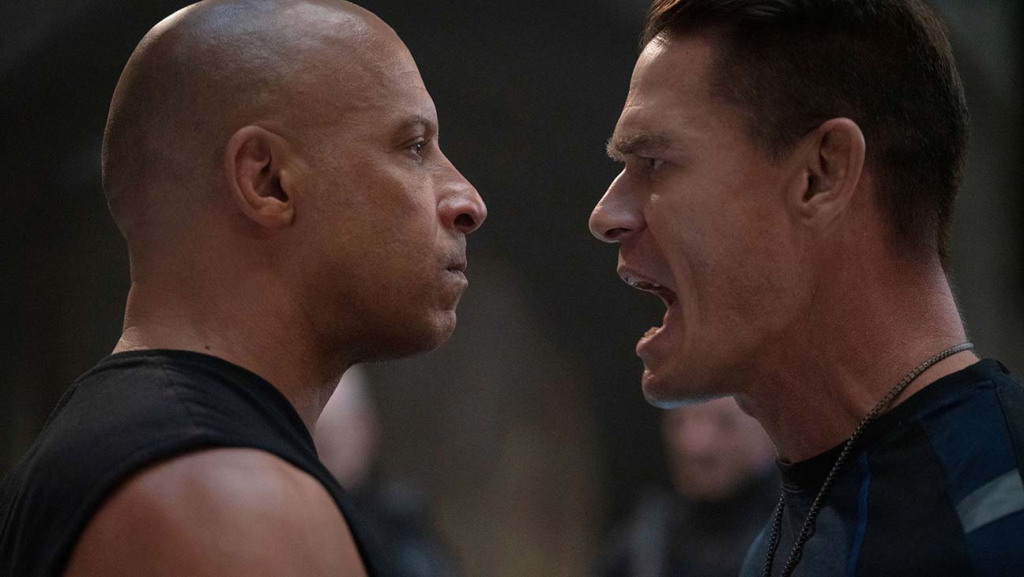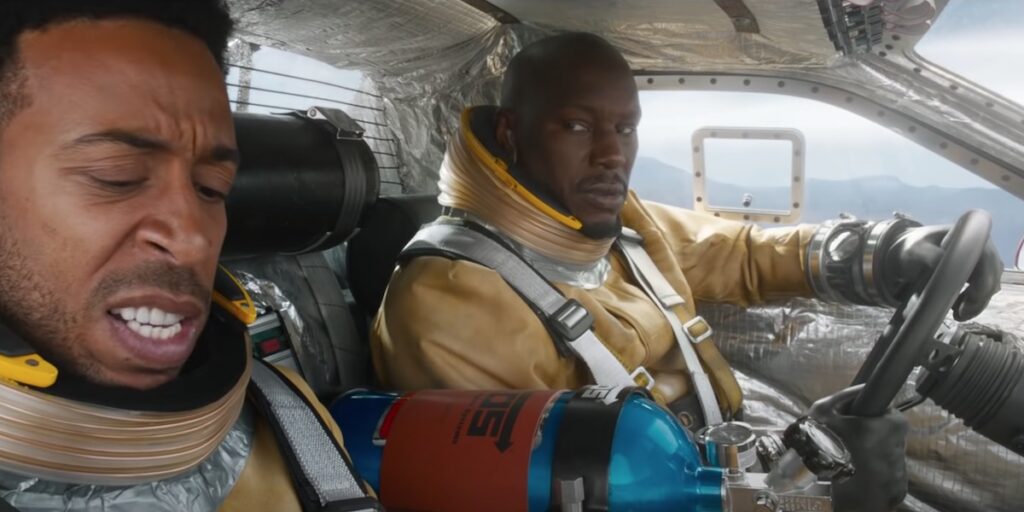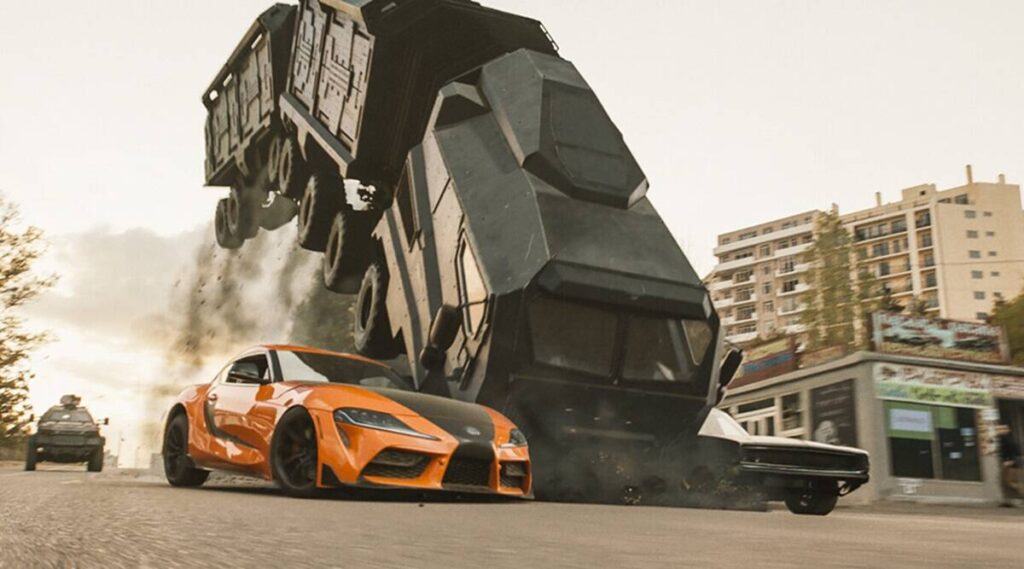
The Fast and Furious movies are rarely funny—what passes for comedy typically involves shrieks from Tyrese Gibson, followed by pained reaction shots from Ludacris—but at least one moment in F9: The Fast Saga made me laugh. Describing the logistics of an impending piece of preposterous derring-do, Tej (Ludacris) calmly declares, “As long as we obey the laws of physics, we’ll be fine.” To quote Frances McDormand in Almost Famous: funny joke! It’s been two decades since this nominal saga began with a B-movie production of underground street racers hijacking trucks full of DVD players; as the installments have grown increasingly expensive and elaborate, their interest in physical plausibility has correspondingly waned to the point of vanishment. Over the course of F9’s long and loud 145 minutes, cars don’t just zoom down roads and across bridges and into the occasional wall; no, they leap off cliffs and crash through department stores and even careen through outer space. Forget physics—the only law this movie is interested in obeying is the law of the sequel.
This isn’t necessarily a complaint. While there’s something to be said for cinematic action that’s rooted in real-world corporeality, films that use convincing special effects to distort and exaggerate reality carry their own outsize appeal. My issue with the maniacal chaos of F9, which was directed by Justin Lin (helming his fifth entry in the franchise, and first since Fast & Furious 6), isn’t that it’s unrealistic but that it’s unexciting. No one could possibly accuse this movie of lacking energy or noise, but it rarely executes its vehicular mayhem with wit or distinction. It’s less an issue of credibility than anonymity; the film’s defining aesthetic personality is no more inventive than Cars Go Vroom.
To be fair, before it succumbs to exhaustion, F9 does exhibit a few flashes of imagination. Its first major set piece, a chase through a minefield in Central America, cleverly places a life-or-death premium on speed, as cars must roar over IEDs at sufficient velocity to evade the radius of the subsequent blast. That sequence also steers into one of the film’s rare moments of relative stillness, a Jurassic Park-style “jeep in the tree” scene which finds Roman (Gibson) trapped in a gargantuan tank-like vehicle that threatens to plunge downward to his explosive doom. And it concludes with a pair of outrageous sights that, if not remotely believable, are nonetheless memorable: first, a sports car plummeting into a ravine only to magically attach itself to a nearby plane, and second, another car sling-shotting its way across the same abyss via little more than a tow cable, a jolt of nitrous oxide, and a very determined press of the gas pedal.

Sure, it’s ludicrous (feat. Ludacris!), but it’s also legible and eye-catching. Yet as F9 progresses, its action grows increasingly repetitive and tiresome. Like Jesse Pinkman before him, Lin has discovered an enthusiasm for magnets, and here he has liberally interpreted the scientific process of attraction and repulsion as an excuse to hurl enormous chunks of metal across the screen. Initially, the idea shows some promise; when the computer expert Ramsey (Nathalie Emmanuel), an unpracticed motorist with a heavy foot, finds herself behind the wheel of a yellow delivery truck that houses a colossal magnet in its bed, she quickly develops a knack for thwarting her pursuers, wielding the device to turn parallel traffic into bumper stickers. But as with everything else in F9, the gimmick quickly wears thin. We’re all familiar with those archetypal shots in chase scenes of characters strategically yanking their gearshift in order to gain a crucial boost, rushing ahead of their enemy in the nick of time. (I often wonder why they were previously driving at suboptimal speed, but never mind.) Here, Lin applies that dubious logic to magnets as well; there are countless shots of people frantically twisting the knobs of glowing instruments, miraculously upending all vehicles in their path. The cumulative effect is numbing; lodestones shouldn’t feel this heavy.
Mass has become a problem for the Fast franchise, which ostensibly stands for popcorn-munching fun that’s buttered with dollops of sincere emotion, but whose solemnity has verged on lugubrious. Here, again and again, F9 buckles under the weight of its own history. It often plays like a valentine to its devoted fans (and to Corona, duh), whether that means bringing back Tokyo Drift’s Lucas Black, splicing in archival footage of the long-departed Gal Gadot, or resurrecting a beloved character in Han (Sung Kang), who died midway through the third film (and also at the end of the sixth? I get confused). The impermanence of death is fair game in modern blockbuster cinema, but the real-life demise of Paul Walker proves trickier to navigate; the screenplay, by Lin and Daniel Casey, repeatedly attempts to explain away the character’s absence, but that metaphorical empty chair at the backyard barbecue is starting to feel an awful lot like a tomb.

Our chief gravedigger and pallbearer is also our guiding light and master of ceremonies. I’m talking, of course, about Vin Diesel, who plays the barrel-chested Dom Toretto, and whose franchise primacy is now unquestioned (especially with Dwayne Johnson slinking off to jungle cruise lines for Disney). Flick on any recent Fast film for more than five minutes, and you’ll invariably hear Diesel’s low-throated rumble sanctify the importance of family, which the franchise has always lovingly conceived of not as a matter of bloodlines but as a shared understanding of loyalty and honor.
Until now. In a mystifying decision, F9 elects to give Dom a brother, Jakob (John Cena), rendering its philosophical focus on family stupefyingly literal. Stranger still, the plot pivots on a faintly absurd flashback to 1989, when a young Dom (Vinnie Bennett) served as an adviser on the competitive racing circuit to his father, who dies in a fiery crash thanks to the chicanery of a jealous Jakob. (I hesitate to question the structural details of a movie that features a Pontiac Fiero strapped to a spaceship, but the screenplay here equates racing to boxing and posits that drivers routinely “throw” events, a suggestion that fabulously misapprehends how gambling works.) The lingering trauma of that patricide is the pretext that draws Dom and his wife, Letty (Michelle Rodriguez), out of their paradisiacal retirement and into a spy game that centers on Jakob’s quest for multiple MacGuffins—called Project Ares, they’re essentially two halves of a slick-looking Nerf football—plus the usual Bondian threats of world domination, nuclear proliferation, yadda yadda.

The banality of the story isn’t fatal; you don’t watch these globe-hopping pictures for their ruminations on geopolitical intrigue. But F9 does strive to invest its steroidal sibling rivalry with genuine stakes. It fails, partly because the actors aren’t up for it. Over the years, Diesel has turned the role of Dom into something of a glowering Zen master—he can imbue stale pronouncements about love and duty with echoes of actual wisdom—but he still doesn’t possess much range, either emotionally or vocally; he reads all of his lines in the same tone of admonishing gruffness, like he’s chastising a waiter for botching his order. As for Cena, he’s previously evinced a light touch with comedy in movies like Trainwreck and Blockers, but despite his imposing size, he simply lacks the gravitas to be taken seriously as a terrorist mastermind; when he shares the screen with Charlize Theron (outfitted in skintight red leather pants and a snappish bowl cut), you get the sense that the three-time Oscar nominee is playing with her food.
But even Academy Award winners would struggle with the film’s script, which flits between strained stabs at humor—such as Roman repeatedly wondering if their crew is invincible (cue mocking laughter from Ramsey and Tej)—and ponderous gestures toward profundity. Much of the dialogue consists of antithetical aphorisms, rhythmically delivered with dramatic pauses befitting shock-jock radio. Jakob to Dom: “I spent my entire life in your shadow… and now you spend the rest of yours living in mine.” Later, Dom’s counter: “No one outruns their past… and yours just caught up to you.” (Frankly, a quick shot of Jakob wincing as Dom embraces the returning Han crystallizes the brothers’ twisted relationship more effectively than any dialogue.) By the time Han declares that dying was the best way for him to stay alive, I started searching my pockets for fortune cookies.
Lin, making his first feature in five years (following the terrific Star Trek Beyond), is far more comfortable with cars than with people, and I mean that visually as well as narratively. In addition to the expected chases and crashes, F9 features quite a few rough-and-tumble fight scenes, all of which are leaden and incoherent. Lin’s choreography of the big-money sequences may be sloppy and monotonous, but at least they contain sporadic moments of awe, such as when a leviathan on wheels gets tipped up into the air and temporarily turns into a motional skyscraper. In contrast, the hand-to-hand combat is flat and grey.

Lin’s filmmaking is largely colorless and dour (despite perky cameos from Helen Mirren and Cardi B), but on one occasion, he delivers images that match F9’s quasi-epic pitch. Drowning in a pool of murky green water, Dom’s mind suddenly returns to his youth, recalling critical information that led to his father’s death. In terms of plot, the scene is freighted with importance, but what’s striking is the staging, most notably a mirror shot that places Diesel in the foreground and the younger Bennett in the looking glass, both gazing mournfully at the parent they loved and lost. It’s a bold, nigh surrealistic sequence that briefly justifies the film’s obsession with its own mythology.
But only briefly. For the most part, and especially as it screeches toward its clamorous conclusion, F9: The Fast Saga stalls out when it should speed ahead. On one level, it’s bizarre that the movie spends so much time chasing its own tail rather than pushing itself creatively. Yet it’s also logical. The clue is in the subtitle; this is blockbuster filmmaking at its most corporatized and sagafied, and the reward of watching a new installment is to be reminded of the old ones. And so the Fast & Furious franchise rages on, burning rubber against the pavement, borne back pointlessly into the past.
Grade: C
Jeremy Beck is the editor-in-chief of MovieManifesto. He watches more movies and television than he probably should.
